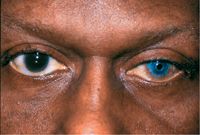Article
Artificial cornea holds promise for high-risk eyes
Several situations are associated with a high risk of failure after donor corneal transplantation. Encouraging results have been seen with a particular keratoprosthesis (Boston KPro, Massachusetts Eye and Ear Infirmary) as an alternative in carefully selected eyes.

Key Points
Baltimore-Keratoprosthesis surgery can be an important option for vision reconstruction in carefully selected patients with corneal blindness, said Esen K. Akpek, MD, at the Current Concepts in Ophthalmology meeting, Baltimore.
"Donor corneal transplantation continues to be the mainstay for vision rehabilitation in individuals with corneal pathology, such as patients with pseudophakic bullous keratopathy or Fuchs' endothelial dystrophy, which represent the main indications for corneal replacement, and the outcomes tend to be very good," said Dr. Akpek, associate professor of ophthalmology, Wilmer Eye Institute, and director, Ocular Surface Diseases and Dry Eye Clinic, Johns Hopkins Hospital, Baltimore. "However, in a variety of other situations-such as [in] individuals with ocular surface problems, pediatric cases, and in eyes with previous graft failure-the prognosis after donor corneal transplantation is poor.

Constructed of polymethylmethacrylate (PMMA), the type 1 device consists of three parts-a front plate, a stem, and a posterior plate. Donor corneal tissue, which does not need to be transplantation quality, is placed between the anterior and posterior plates, and the assembled unit is sutured into the recipient eye.
The type 2 device is designed for use in patients with end-stage ocular surface disease who have no fornices to support a tear film and the implant.
Candidates

"Congenital aniridia involves the entire anterior segment, and in addition to corneal opacity, there is glaucoma and abnormal limbal stem cells that make these eyes poor candidates for a donor corneal graft. Our experience with the [keratoprosthesis] to date shows it is associated with great success without any device-related complications," said Dr. Akpek.
Persons with keratoconjunctivitis sicca also do reasonably well, whereas the prognosis tends to be poorer in eyes with inflammatory ocular surface disease, such as cicatrizing conjunctivitis related to Stevens-Johnson syndrome or mucous membrane pemphigoid.
Implantation of the type 1 device has been associated with low rates of intraoperative complications. Several complications can occur postoperatively, although the risks have been reduced with improvements in device design and postoperative care. Patients return for frequent visits after the surgery and are treated with a topical corticosteroid and vancomycin while also sometimes receiving oral doxycycline and acetazolamide. In addition, patients wear a large-diameter, high-water-content soft contact lens indefinitely to protect the device and prevent melting.
Newsletter
Don’t miss out—get Ophthalmology Times updates on the latest clinical advancements and expert interviews, straight to your inbox.




